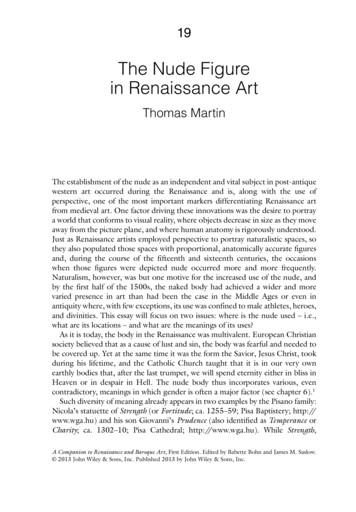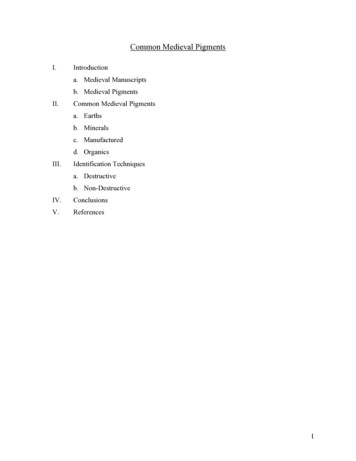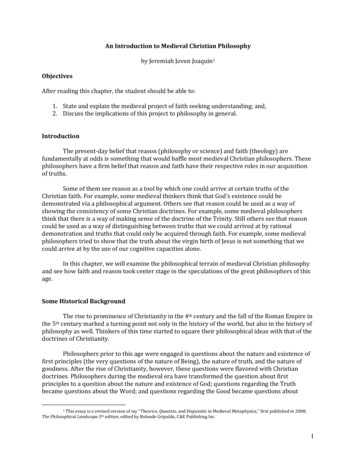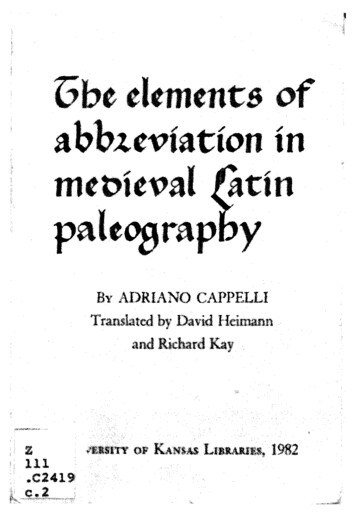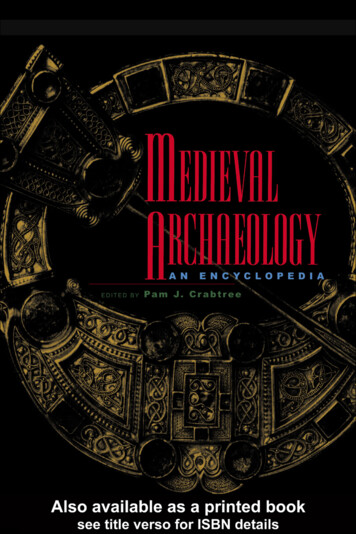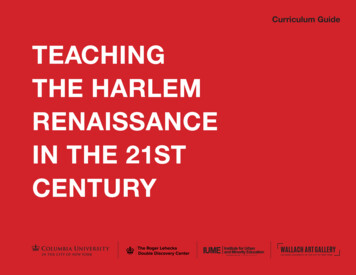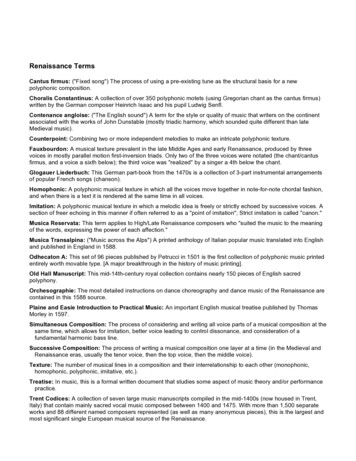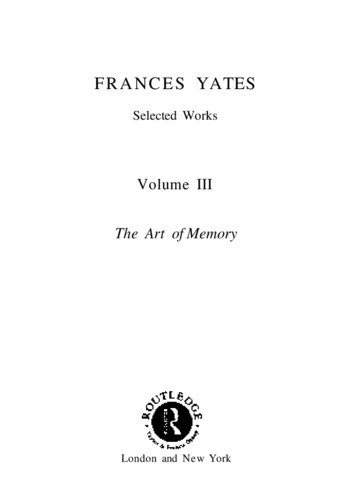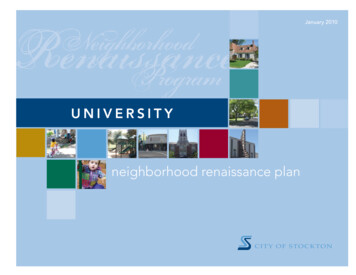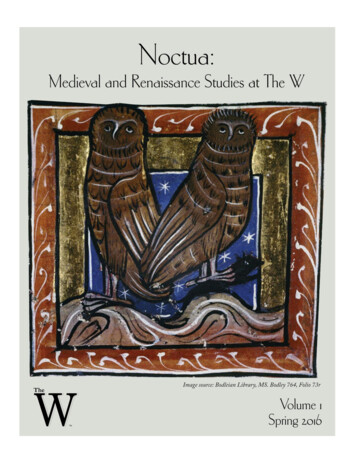
Transcription
1Noctua:Medieval and Renaissance Studiesat The WVolume 1Spring, 2016Editor:Elizabeth VarvelFaculty Advisor:Dr. Kristi DiClemente
2True Love and Devotion as Defining Characteristics of the Women in The Lais of Marie DeFranceRain GerteisThe Lais of Marie de France is a collection of courtly love poems written in the twelfthcentury by a French woman known only by the name, Marie. This collection of lais belongs tothe larger genre of courtly romance, and each of these tales tells a fairly similar story of tragicand forbidden romance. This concept of forbidden love was a defining characteristic of the genreof courtly love and is present in stories such as Chaucer’s “The Knight’s Tale” and severalpopular Arthurian tales. Courtly romances generally focus on a male character, usually a knight,who falls in love with a beautiful but unattainable woman. The knight has to undergo varioustrials to prove himself worthy of the woman’s love. Love is depicted as a constant struggle whichonly the most worthy and admirable characters are willing to face. Female characters play keyroles in stories of courtly romance by driving the actions of the male characters, however, theirperspectives and personalities are limited to their roles as objects of male affection. Womenrarely take on active roles in these stories, serving as a passive reward for the struggles andachievements of the male characters.Several of the stories in The Lais of Marie de France do not fit these standards andprovide more fully-developed and active female characters than the typical romance, like thewomen in the lais Equitan and Bisclavret. This has led many historians and literary critics, likeJudith Rice Rothschild and Sarah-Jane Murray to view Marie’s lais as a subversion of the genre.However, this is not evidence that Marie is in any way challenging the conventions of courtlyromance. In fact, The Lais of Marie de France reinforce the traditional depictions of women in
3courtly romances through both their contrasting depictions of good and wicked women, as wellas the resulting punishment for women who are not able to uphold the feminine ideal.In order to understand how Marie’s less traditional female characters fit into herdepiction of women as a whole, it is important to understand how women were typically depictedin courtly romances. This is difficult to establish, as many works which are considered courtlyromances do not fit the common definition of courtly love relationships. Courtly romances areoften defined as depicting female character who, through their great beauty, command controlover a man who must work to win her love, “for love of her he must become pale thin andsleepless” (Capellanus 5). However in her introduction to The Lais of Marie de France, GlynBurgess challenges the idea of a concrete definition of courtly love, writing that “love inmedieval literature, as in any other period, is too complex to be reduced to a single model whichwill not admit of variation” (Marie de France 27-28). Burgess goes on to say that while theycertainly differ in characterization from classic tales of courtly love like the stories of Guinevereand Lancelot, some of the lais, like Guigemar, do fall into the category of courtly romances.Defining the role of female characters in courtly romances is equally problematic, and scholarsfrequently disagree on whether courtly women should be defined by their physical passiveness ortheir emotional influence over male characters (Wollock 6-7).With such conflicting definitions of how women should be understood in courtlyromances, how can a working definition of the traits of courtly women be created? Despite theiroften vast differences in characterization, the women of courtly romances are stronglycharacterized by their desirability and passiveness, in that they do not take action against malecharacters. Women in courtly romances are always depicted as an object of desire for the malecharacter(s) in the story. Courtly love stories, like Chaucer’s “The Knight’s Tale,” place great
4importance on the beauty of the female character, with extensive descriptions of her kinddemeanor and exceptional looks. Chaucer describes the object of affection in this tale, a womannamed Emelye, writing that she was “that fairer was to sene/Than is the lylie upon his stalkegrene” (Chaucer). In addition to her beauty, the woman proves her good character by remaininga passive bystander to the fighting of the two knights in the story, who both want to win her love.Whether or not they return the love of the knight, and some of them do not, these women neverbecome the enemies of the male characters. They can be indecisive and sometimes unlikablecharacters, and, like Guinevere, a source of conflict in the story, but they themselves rarely takeactive actions against other characters.Marie’s lais contain their own definition of the ideal courtly woman, defining her as, inaddition to being beautiful and passive, faithful to her lover. While mutuality in love is not anecessary feature of courtly romances, Marie consistently depicts the ideal young lovers as beingfaithful to one another. These two lovers are “nearly always on their own and pitted against evilin various forms: a jealous husband an envious society,” and “it is in fact by virtue of their lovingthat the protagonists are set apart from the rest of society and privileged” (Marie de France 27).In these lais, devotion and mutuality in love are key characteristics in defining the ideal courtlywoman.Upon an initial reading of these stories, the quality of faithfulness does not seem to play apart in any courtly romances. In fact, women in medieval romances were typically alreadymarried before they met the young knights who would become their lovers. Marriage is oftendepicted as an obstacle that prevents the two lovers from being together. Embodying the qualityof faithfulness in courtly romances does not require a woman to be faithful to the man she is
5married to, but rather, the man who loves her. In being faithful to love, even despite obstacleslike marriage, a woman embodies the courtly feminine ideal.This view of love and marriage can be traced back to the origins of courtly romance inthe writings of the Roman poet, Ovid. In his work, Ovid defines love as purely extramarital “and(it) does not contemplate matrimony as its object” (Capellanus 4). While the writings of Ovidwere satirical, and present a view of love that is much too cynical to be truly romantic, theseideas were taken very seriously by medieval authors of courtly love stories and provided much ofthe basis for these works (Capellanus 4). The concept of love as a constant struggle to beovercome is present throughout courtly romances of the Middle Ages, and has a clear influencein The Lais of Marie de France as well.Several of the women in the lais which follow the tradition of courtly romances areadulterous, and they seek true love outside of their happy marriages. The husbands of the womenin these tales are old, cruel, and unable to provide their wives with children. In fact, Mariecriticizes these old men in Guigemar, in which she writes that “all old men are jealous and hateto be cuckolded” (Marie de France 46). While cuckoldry is certainly depicted negatively in someof the other lais, Marie seems to indicate that cuckoldry can only be expected when a husbandhas nothing to offer his wife and is cruel to her. The women are not happy in these marriages,and their infidelity is justified by their search for true love with another, more fulfilling partner.Despite their infidelity to their husbands, the women in these lais still uphold the idea offaithfulness which defined “good” medieval women. In these stories, it was not so much thewomen’s faithfulness to their husbands which defined their characters, but their obedience to themen in their lives. These women display their passiveness by enduring their unfortunatecircumstances until a knight comes to save them, rather than taking their own actions to free
6themselves from their husbands. In fact, the women do remain obedient to their husbands untilthe point that the knights comes along, actively seeking out these women. At this turning point inthese stories, the women become devoted to true love rather than their husbands, and theirwillingness to pursue love despite the obvious dangers is what characterizes them as admirableand upholding of the courtly feminine ideal as defined by Marie de France.This idea of female obedience is particularly exemplified in the lai, Yonec, in which abeautiful woman is confined to a single room in a tower by her jealous husband. The husband isdescribed as very old, and he is not able to provide his wife with any children. The woman inYonec embodies the ideal medieval woman in both looks and behavior. She is described as “fairand noble,” and her kind personality and passiveness denote her as a “good” woman (Marie deFrance 86). It is because of her beauty and good character that she attracts a lover who literallyflies in through her window as a hawk and transforms into a knight who claims that he hasadmired her from afar and loves her unconditionally. Despite their love for each other, the laiends tragically, and the knight is eventually killed by the woman’s jealous old husband. Eventhough the knight is dead, the woman remains faithful to him by obeying his request for her tostay with her husband and allow her son to avenge his real father when he is old enough. Sheendures her husband’s cruelty for several more years and dies from fainting just before her sonkills her old husband. In dying, the woman proves her devotion to the knight, showing that shewas truly devoted to him because, now that her promise to him has been fulfilled, she is nolonger able to live. Her death proves that she really was worthy of the knight’s love andembodies Marie’s idea of the ideal courtly woman.The woman in the lai Guigemar faces similar circumstances to the lady in Yonec,although her story has a happy ending. Guigemar tells the story of a man who comes across
7beautiful woman with whom he immediately falls in love. This woman has also been confined tothe castle by a jealous husband, and the woman in Guigemar also remains obedient to herhusband, expressing hesitation before forming a relationship with the knight. Although she doesmake the decision to take in the knight, defying her husband, the woman does this because theknight is wounded. She is justified in her decision to take in the knight because if she did not, hewould die. The woman falls in love with the knight, but after a short time together, her husbandcomes back and forces the knight to leave. The two lovers face great hardships over severalyears, but are eventually reunited and allowed to be with one another as a reward for theiradmirable devotion to one another.The fact that the woman and the knight are in love is an important aspect of both of thesestories, and justifies the women’s unfaithfulness to their husbands. In courtly romances, love wasseparate from marriage, which was often depicted as oppressive and inherently loveless, leadingmarried people to look outside of their marriages to find love. While Marie does not present sucha cynical view of marriage in The Lais of Marie de France, ending some of the tragic anddifficult romances with happy marriages, she definitely depicts love and marriage as existingseparately, and presents the idea that adultery is not acceptable if it is done out of love. Mariedepicts marriage as a societal convention which often gets in the way of true love, which makessense when taking into consideration that medieval noblewomen rarely had the opportunity tochoose to whom they were married, and they entered marriages for political and economicreasons rather than as an expression of love. For women, courtly love stories were often a way of“gaining control of their own choice in love and marriage” (Wollock 7). Marie supports thisfantasy of gaining female agency in romance, but with a clear emphasis that this agency shouldonly apply to situations in which two people are truly in love. In Guigemar, Marie shows that
8“love, even adulterous love, if loyal and deep, need not necessarily lead to the death of thelovers” (Marie de France 29). This distinction is important in understanding some of Marie’sother lais. Marie does not criticize love on the basis of adultery, but based on the faithfulness ofthe two lovers.Several of the lais in The Lais of Marie de France present a far more critical view oflove. In these stories, the characters abandon loving relationships in pursuit of a much moreselfish and purely physical love. Lais like Bisclavret and Equitan are often seen as a challenge tothe genre of courtly romance because of the depictions of love and women in these lais. Thewomen in these lais do not represent the idea woman of courtly romances, taking on roles asantagonists in the story and characterized by their deceptive nature. While these lais do not fit inwith the more traditional tales of courtly romance and have far more in common with thetraditional fabliau, they are not necessarily out of place in the Lais of Marie De France. Two ofMarie’s characters, the women in the lais Bisclavret and Equitan, are a clear antithesis of thiscourtly feminine ideal. Both of these lais are far more critical of the motivations of theircharacters and more moralistic in tone than some of the other lais, like Yonec and Guigemar,which fit the traditional pattern of courtly romances. Medieval literary scholar Sarah-JaneMurray discusses some of the lais, particularly the lai Lauüstic, as criticisms of the conventionsof courtly love and the portrayal of adultery in these tales, but an important distinction is madewhen she writes that “Marie’s text can be understood as a subtle and very interesting critique ofthe covetous and destructive kind of selfish love, or cupiditas, portrayed therein” (Murray 2).The Lais of Marie de France do not offer a criticism of courtly love, but a criticism of selfishlove and an inability to uphold courtly famine ideals.
9Medieval scholar Judith Rice Rothschild explains that while she believes the lai Equitanfits in with the rest of The Lais of Marie de France, “Marie does attack l’amour courtois”(Rothschild 115). According to Rothschild, the lai has far more in common with the traditionalfabliau, and the lai is included more as a criticism of many of the conventions of courtly romancethan another work in that genre. While both Equitan and Bisclavret do have far more in commonwith the traditional narrative of a fabliau, their place in The Lais of Marie de France contributesto the positive messages about women who uphold the ideas of courtly romance as depicted inother lais. Equitan tells the story of a happily married woman who betrays her husband byseeking out a relationship with the king. This story is interestingly, told right after Guigemar,which is credited as following the traditional format of the courtly love genre (Marie de France29). Equitan greatly contrasts the story of Guigemar in its depiction of love. In this story it isimportant to note that both the king, Equitan, and the woman he falls in love with express doubtsabout pursuing this relationship. Equitan believes that only a man possessing of his wealth andstatus is deserving of such a beautiful woman, and his interest in this woman is depicted ashaving formed more out of pride than genuine affection. The woman also does not seemgenuinely affectionate towards Equitan, becoming jealous and vowing to kill herself if hemarries another, younger woman. To prevent this from happening, the woman plans to kill herown husband so that she will be free to marry Equitan. The lai ends with a moral: “evil can easilyrebound on him who seeks another’s misfortune” (60).While this lai can be interpreted as a challenge to the genre of courtly romance in that itdepicts characters pursuing extramarital affairs in a negative light, this argument does not makesense in comparison with lais like Guigemar and Yonec, which depict adultery as tragic, but notevil. In fact, Equitan actually supports the messages about courtly female behavior presented in
10the other lais. Marie makes it clear that in this situation, it was not the wife’s adulterousbehavior, but her decision to take action and kill her husband that led to her death. Instead ofwaiting for her lover to save her from her marriage, which is happy, she decides to kill herhusband herself in order to get what she wants. Whether or not the woman is truly in love doesnot matter in this story, because she has gone beyond devotion to love by killing her husband, aninnocent man. Burgess also agrees that it is the lover’s “plan to dispose of the lady’s husband”which defines the characterization of Equitan and the knight’s wife, explaining that what theselais offer is a “condemnation of disloyalty” (Marie de France 30).This moralistic disapproval of unfaithfulness also appears in the lai Bisclavret. InBisclavret, a woman discovers that her husband is actually a werewolf. After interrogating himabout his condition, she finds out that after her husband transforms into a wolf he cannot becomehuman again unless he puts his clothes back. Upon learning this, the woman “tormented andharried him so much that he could not do otherwise but tell her” where he keeps his clothes whenhe transforms (Marie de France 69). Although she promises not to take his clothing, the womandeceives her husband, stealing his clothes and forcing him to remain a werewolf. After this shepursues an affair with a man she does not love, but who loves her. The woman’s husband isdescribed as a “good and handsome knight who conducted himself nobly,” and it is clear that heloved his wife. While the woman “returned his love,” and she is described as a beautiful andworthy wife, she breaks her promise to her husband (68). While Marie follows the traditionaldepiction of courtly women’s beauty as a signifier of their good personalities in several lais, “shealso seems to be aware that a pleasing exterior can mask a potential for cruel and misguidedbehavior” (Burgess 116). The women in Bisclavret and Equitan are deceptive in both theirpersonalities and appearances.
11Because they do not uphold the feminine ideal of these stories, the women in Bisclavretand Equitan could be interpreted as a challenge to the feminine ideal. Although the storiesresemble those of courtly love stories in plot, the women in these lais have almost nothing incommon with women like Chaucer’s Emelye. The women in these lais are selfish, disobedient,and scheming, and they take on extremely active roles in their stories, making an effort todetermine their own endings. However, in the context of The Lais of Marie de France as awhole, these lais uphold the concept of the ideal courtly woman rather than challenge it. Thesestories are not part of the genre of courtly romance, but they do reinforce the ideas of courtlylove by stressing the punishment of the characters who do not conform to the ideals of courtlyromance. While it is difficult to determine Marie’s exact stance on the concept of courtly love, itis clear that she views characters who embody the qualities of love and devotion favorably, andcharacters who make an active effort to destroy love are depicted negatively. Unfaithfulness inmarriage is only acceptable when the marriage results in the tragic mistreatment of a woman, butwomen who betray good husbands simply to fulfill their own selfish desires are portrayed aswicked. The women in the lais Bisclavret and Equitan deceive their kind and loving husbandsnot because they are in love with these other men, but because they do not respect the love thattheir husbands have for them. It is especially difficult to view these women as a challenge to themore traditional depictions of women in courtly literature when taking into consideration thatboth of them receive just punishment for their actions at the end of the lais.Appearance plays an important part in the punishment of the woman in Bisclavret, andher beauty is removed at the end of the story to reveal her true nature. As punishment, thewoman and the man she left her husband for are exiled together. In contrast to the woman inYonec, who actually regains her beauty after falling in love and becoming herself again, the
12woman in Bisclavret has her nose cut off to expose the ugliness of her true personality. Thewoman in Yonec is rewarded with beauty to reflect her personality once she experienceshappiness in a loving relationship, and the woman in Bisclavret loses her beauty as a result of herbetrayal of the man who loves her. The woman is described as having several children who areborn without noses, and many of the women in her family for generations after her are bornwithout noses as punishment for this woman’s trickery. Marie is clearly making a statementabout the morality of this woman’s actions. Medieval historian Carl Grey Martin writes that thewoman’s punishment “asks its audience to ascertain the moral qualities and duties of hercharacters,” and the conclusion the reader is meant to come to is that the woman was wrong forbetraying her loving husband (25). The woman in Equitan is also punished for her actions, andshe is pushed into a tub of boiling water by her husband.The punishments of these women are a direct result of their actions in the lais. Thesewomen do not uphold the standard of the ideal courtly woman, and they are stripped of theirdeceptive beauty and forced to either live in misery or die. Their inability to embody this ideal ofthe passive, beautiful, and faithful woman, whom Marie depicts in lais like Guigemar and Yonec,is what leads to the tragic ends of these women. Unlike traditional courtly women, whoadmirably endure the tragedies of their romances and devote themselves to true love, thesewomen chose to betray love by deceiving their kind husbands.Although these lais are not truly courtly romances in that they differ from the genre inboth plot and tone, they do uphold the ideas of the courtly romance by presenting an alternativedepiction of wicked women who do not embody the feminine ideals of courtly romance. Despitetheir differences from some of the more traditional courtly lais, stories like Bisclavret andEquitan cannot truly be considered a challenge to the conventions of courtly romance, because
13Marie depicts these aberrations from the genre as deceptive and wrong. The good women inGuigemar and Yonec show how courtly women were supposed to behave, and these other storiesare included as a moralistic alternative to this depiction of women. The morals at the end of bothEquitan and Bisclavret make it clear that Marie does not approve of the selfish actions of thewomen in these stories. While her exact opinion on the nature of courtly love is not clear, Marieis certainly not challenging the conventions of courtly love, and seems to be of the opinion thatcourtly romances can even be good if the feelings of the lovers are truly based on devotion andmutuality in the relationship. Marie’s inclusion of these alternative depictions of women inBisclavret and Equitan reinforces this idea, showing that women who actively betray love aredeserving of punishment for their inability to represent the courtly feminine ideal.Works CitedBurgess, Glyn S. The Lais of Marie de France: Text and Context. Manchester: ManchesterUniversity Press. 1987. Print.Capellanus, Andreas. The Art of Courtly Love. Trans. John Jay Parry. New York: ColumbiaUniversity Press, 1960. Print.Chaucer. “The Knight’s Tale Part 1.” The Geoffrey Chaucer Page. Web. 2 May 2016.Marie de France. The Lais of Marie de France. Trans. Glyn S. Burgess and Kieth Busby.London: Penguin Books, 1986. Print.Martin, Carl Grey. "Bisclavret and the Subject of Torture." The Romanic Review 104, no. ½(2013): 23-43. Print.Miller, Robert P. "The Wounded Heart: Courtly Love and the Medieval Antifeminist Tradition.“Women's Studies 2.3 (1974): 335-350. Print.
14Murray, K. Sarah-Jane. "Marie de France, Ethicist: Questioning Courtly Love in Lauüstic."Modern Philology 109, no. 1 (2011): 1-16. Academic Search Complete. Web. 17 Apr.2016.Rothschild, Judith Rice. “Marie de France’s Equitan and Chaitivel: Fin’ Amors or Fabliau?” TheWorlds of Medieval Women Creativity, Influence, Imagination. Ed. Constance H.Berman, Charles W. Conness, and Judith Rice Rothschild. Morgantown: UniversityPress, 1985. 113-121. Print.Wollock, Jennifer G. Rethinking Chivalry and Courtly Love. Santa Barbara: Praeger, 2011. Print
grene" (Chaucer). In addition to her beauty, the woman proves her good character by remaining a passive bystander to the fighting of the two knights in the story, who both want to win her love. Whether or not they return the love of the knight, and some of them do not, these women never become the enemies of the male characters.

